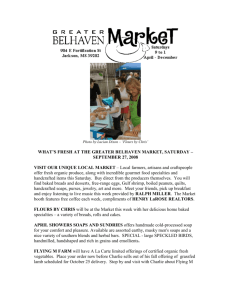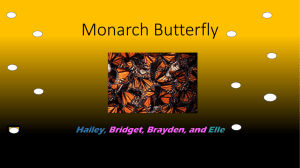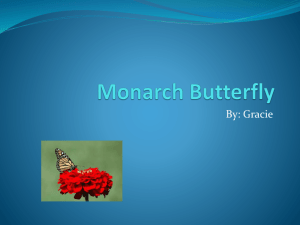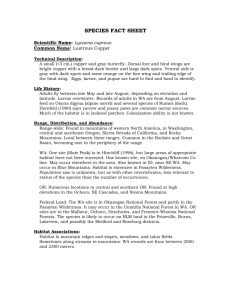Chinquapin (Golden) Hairstreak Butterfly Survey Report Gifford Pinchot National Forest 2008
advertisement
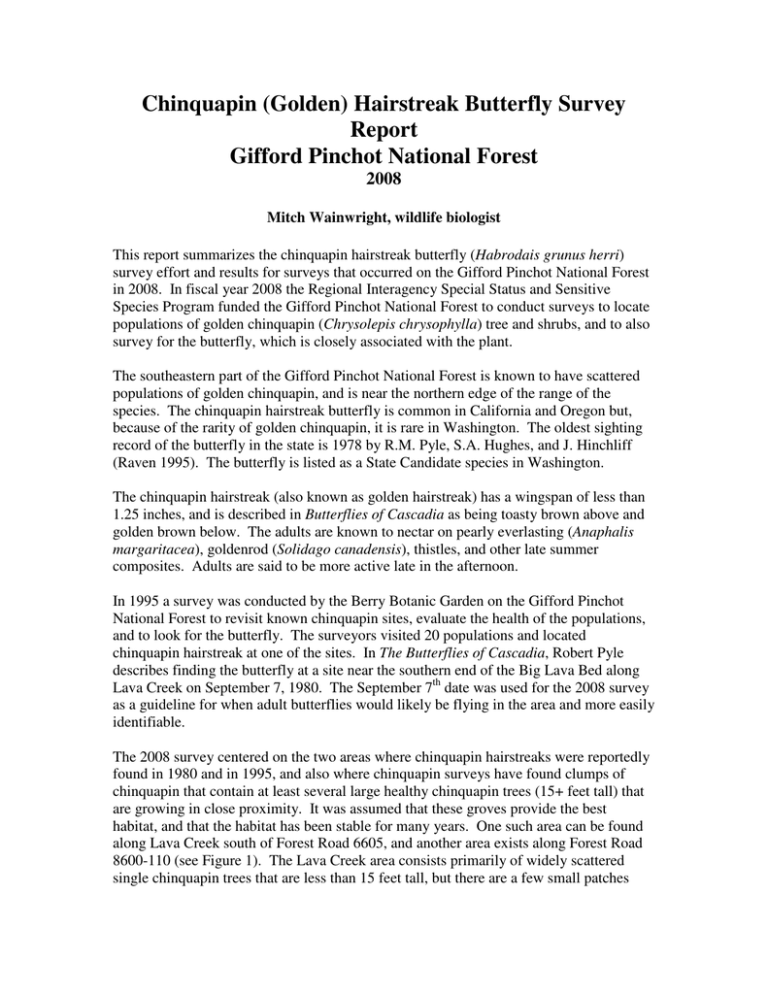
Chinquapin (Golden) Hairstreak Butterfly Survey Report Gifford Pinchot National Forest 2008 Mitch Wainwright, wildlife biologist This report summarizes the chinquapin hairstreak butterfly (Habrodais grunus herri) survey effort and results for surveys that occurred on the Gifford Pinchot National Forest in 2008. In fiscal year 2008 the Regional Interagency Special Status and Sensitive Species Program funded the Gifford Pinchot National Forest to conduct surveys to locate populations of golden chinquapin (Chrysolepis chrysophylla) tree and shrubs, and to also survey for the butterfly, which is closely associated with the plant. The southeastern part of the Gifford Pinchot National Forest is known to have scattered populations of golden chinquapin, and is near the northern edge of the range of the species. The chinquapin hairstreak butterfly is common in California and Oregon but, because of the rarity of golden chinquapin, it is rare in Washington. The oldest sighting record of the butterfly in the state is 1978 by R.M. Pyle, S.A. Hughes, and J. Hinchliff (Raven 1995). The butterfly is listed as a State Candidate species in Washington. The chinquapin hairstreak (also known as golden hairstreak) has a wingspan of less than 1.25 inches, and is described in Butterflies of Cascadia as being toasty brown above and golden brown below. The adults are known to nectar on pearly everlasting (Anaphalis margaritacea), goldenrod (Solidago canadensis), thistles, and other late summer composites. Adults are said to be more active late in the afternoon. In 1995 a survey was conducted by the Berry Botanic Garden on the Gifford Pinchot National Forest to revisit known chinquapin sites, evaluate the health of the populations, and to look for the butterfly. The surveyors visited 20 populations and located chinquapin hairstreak at one of the sites. In The Butterflies of Cascadia, Robert Pyle describes finding the butterfly at a site near the southern end of the Big Lava Bed along Lava Creek on September 7, 1980. The September 7th date was used for the 2008 survey as a guideline for when adult butterflies would likely be flying in the area and more easily identifiable. The 2008 survey centered on the two areas where chinquapin hairstreaks were reportedly found in 1980 and in 1995, and also where chinquapin surveys have found clumps of chinquapin that contain at least several large healthy chinquapin trees (15+ feet tall) that are growing in close proximity. It was assumed that these groves provide the best habitat, and that the habitat has been stable for many years. One such area can be found along Lava Creek south of Forest Road 6605, and another area exists along Forest Road 8600-110 (see Figure 1). The Lava Creek area consists primarily of widely scattered single chinquapin trees that are less than 15 feet tall, but there are a few small patches consisting of five to 15 taller trees (UTM 5072973 N, 601700 E). The Lusk Creek site along the 8600-110 Road (UTM 5083260 N, 603542 E, NAD 27) consists of several clumps totaling about fifty closely spaced chinquapin trees that are 8 to 10 inches diameter and 30 to 40 feet tall. These chinquapin trees are tall enough that the upper canopies are exposed to the sun, potentially making them more attractive to butterflies. Due to the relatively large amount of habitat provided and the apparent stability of the habitat, this site appeared to be the most likely place to find chinquapin hairstreaks. On July 30th initial survey visits were made by Mitch Wainwright (GPNF) and Vince Harke (USFWS) to the Lava Creek site and to the site where the Berry Botanic Garden reported the butterfly in 1995. In addition, searches were made on that day to try to locate groves of larger chinquapin trees, and the Lusk Creek site was noted. No chinquapin hairstreak butterflies were found that day and no sign of feeding by larvae was noted. The site where the butterfly was found by the Berry Botanic Garden is a relatively recent clear-cut that experienced a small wildfire subsequent to the area being logged. The golden chinquapin plants that were found there were all shrubs less than 8 feet tall, and were widely scattered. It did not appear to be an area where chinquapin hairstreaks were likely to be found. This site was not searched again in 2008. On August 6 additional areas were searched by Mitch Wainwright for likely chinquapin hairstreak habitat along Forest Road 6600 where golden chinquapin has been found before. The first area searched was just north of South Prairie. The chinquapin trees that were found there were 5 to 20 feet tall but are growing as widely scattered individual plants, with a density that was estimated to be 1 to 3 trees per acre. In addition, it was noted that there were no, or very few flowers at that time that adult butterflies could use as nectar sources. The second area searched was along both sides of the 6605 Road beginning at its junction with the 6600 Road east to Lava Creek. This is apparently the area where Pyle found the hairstreak in 1980. The chinquapin trees in this area are also widely scattered, especially north of the 6605 Road. The chinquapin appears to be denser and appears healthier south of the 6605 Road because the overstory conifer trees have been thinned, allowing more sunlight to reach the understory chinquapin trees. A small patch of larger chinquapin trees was found in the thinned conifer stand, south of the 6605 and adjacent to the east side of Lava Creek. No chinquapin hairstreaks were noted, and no sign of feeding by larvae was seen. Around noon on August 29th the small grove of large chinquapin trees adjacent to Lava Creek was checked by Mitch Wainwright, and no chinquapin hairstreaks were seen. It was noted that pearly everlasting was beginning to bloom along the road edges. It was reported in The Butterflies of Cascadia that this is one of the plants that chinquapin hairstreaks will use for nectar, so a search was made along the road to attempt to locate butterflies that might be nectaring on these flowers, but no butterflies were seen. At about 2:00 pm on August 29th Wainwright went to the grove at the Lusk Creek site and noted three to five yellow-tan colored butterflies flying around the upper canopies of the large chinquapin trees. The butterflies were the right color and the right size to be chinquapin hairstreaks, and they stayed up in the canopies of the chinquapin trees. It appeared that the chinquapin was flowering at that time. Since the butterflies remained 20 to 30 feet off the ground, it was impossible to positively identify them as chinquapin hairstreaks. These butterflies were seen at about 2:30 pm. There were also flowering pearly everlasting plants along the road edges at this site. On September 3rd the Lusk Creek site was checked again by Betsy Scott (GPNF). She observed what appeared to be ten to twenty chinquapin hairstreaks flying around the canopies of some of the tall chinquapin trees between 2:00 pm and 4:00 pm. After 3:00 pm some of the butterflies appeared to move lower and were observed near vine maple closer to the ground. She was unable to capture any for positive identification. On September 5th Wainwright and Scott returned to both the Lava Creek site and the Lusk Creek site. No butterflies were seen at the Lava Creek site, and the chinquapin trees there did not appear to be flowering. Three to five golden colored butterflies were again seen during the afternoon at the Lusk Creek site. Scott checked the Lusk Creek site again from about 2:30 pm to 4:00 pm on September 8th. She noted two golden colored butterflies at that time. She also checked a large chinquapin tree located in a clear-cut a short distance south of the Lusk Creek site. No butterflies were seen in the clear-cut. Ann Potter, a Wildlife Biologist with the Washington Department of Fish and Wildlife was contacted to get her opinion as to the probable identification of these butterflies as chinquapin hairstreaks. She responded that she could think of no other yellow or gold colored butterflies that are the size of the individuals observed, so it’s more than likely that the butterflies observed on 8/29, 9/3, and 9/5 at the Lusk Creek site were chinquapin hairstreaks. References: Pyle, Robert Michael. The Butterflies of Cascadia. 2002. Seattle Audubon Society. 420 pp. Raven, Andrea N. Summary of the 1995 field surveys for the Golden Chinquapin, Chrysolepis chrysophylla (Douglas) Hjelmqvist, and Herr’s Golden Hairstreak Butterfly, Habrodais grunus berri Field. 1995. Berry Botanic Garden. 47 pp. Figure 1. Lava Creek and Lusk Creek chinquapin sites. Figure 2. Chinquapin trees at the Lusk Creek Site. Figure 3. Chinquapin adjacent to the 8600-110 Road.


